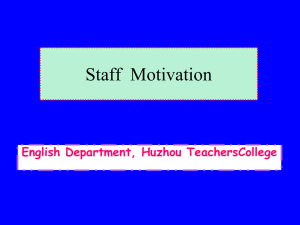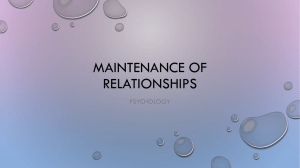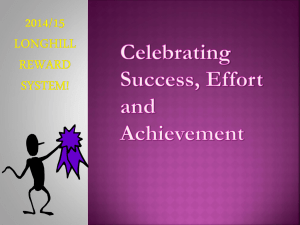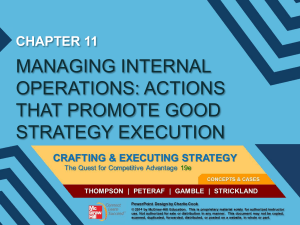DrainFlow Case Study
advertisement
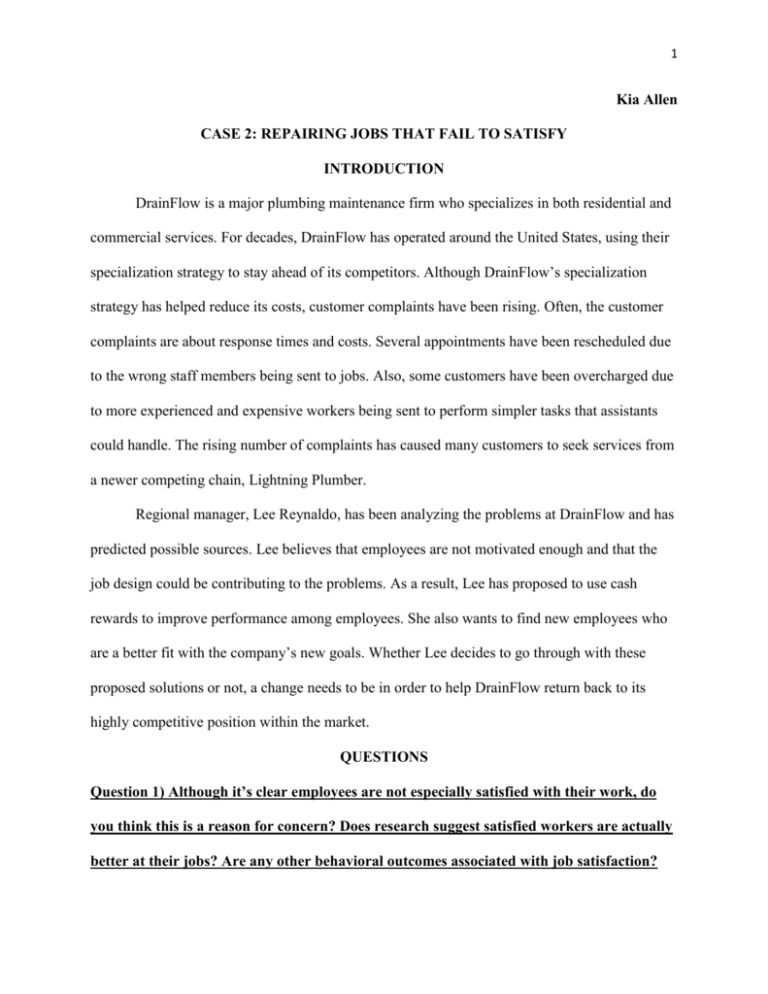
1 Kia Allen CASE 2: REPAIRING JOBS THAT FAIL TO SATISFY INTRODUCTION DrainFlow is a major plumbing maintenance firm who specializes in both residential and commercial services. For decades, DrainFlow has operated around the United States, using their specialization strategy to stay ahead of its competitors. Although DrainFlow’s specialization strategy has helped reduce its costs, customer complaints have been rising. Often, the customer complaints are about response times and costs. Several appointments have been rescheduled due to the wrong staff members being sent to jobs. Also, some customers have been overcharged due to more experienced and expensive workers being sent to perform simpler tasks that assistants could handle. The rising number of complaints has caused many customers to seek services from a newer competing chain, Lightning Plumber. Regional manager, Lee Reynaldo, has been analyzing the problems at DrainFlow and has predicted possible sources. Lee believes that employees are not motivated enough and that the job design could be contributing to the problems. As a result, Lee has proposed to use cash rewards to improve performance among employees. She also wants to find new employees who are a better fit with the company’s new goals. Whether Lee decides to go through with these proposed solutions or not, a change needs to be in order to help DrainFlow return back to its highly competitive position within the market. QUESTIONS Question 1) Although it’s clear employees are not especially satisfied with their work, do you think this is a reason for concern? Does research suggest satisfied workers are actually better at their jobs? Are any other behavioral outcomes associated with job satisfaction? 2 Employees who are not especially satisfied with their work tend to be less motivated to achieve organizational goals. This raises a high concern for the organization, in which organizational goals may take even longer to accomplish. In this case, employees at DrainFlow are not motivated and therefore, lack the customer service that they should be providing. Competitors such as Lightning Plumber offer great customer service in comparison. Lightning Plumber has also created a more vital and energetic work environment. Since the early 1900’s, job satisfaction and job performance have been linked together. Beginning with the Hawthorne studies, happy workers were described as productive workers. Throughout the years, these findings were challenged and the linkage was proven to be moderately strong. Research suggests that organizations with more satisfied workers tend to be more effective than organizations with fewer (Robbins, 2001). In addition to job performance, there are many more behavioral outcomes associated with job satisfaction. These associations can be either positive or negative in regards to performance. An employee’s organizational citizenship behavior (OCB) is highly dependent on their level of job satisfaction. Satisfied employees will go beyond their work expectations simply because they have positive feelings toward their job. Support by co-workers and positive experiences in the workplace usually cause employees to engage in OCB. Also, customer satisfaction has been found to positively contribute to job performance. Satisfied employees have the ability to increase customer satisfaction and loyalty. Currently, DrainFlow is receiving several surveys reflecting customer dissatisfaction. 40% of the total survey respondents felt that their experience was not good while 30% of the total survey respondents disclosed that they would use a competitor the next time they experience a plumbing issue (Robbins, 2001). 3 On the contrary, some associations with job satisfaction can result in negative behavioral outcomes. Absenteeism, turnover, and workplace deviance all have a negative relationship with job satisfaction. When employees are dissatisfied with work and alternative jobs are available, they will have high absence rates. However, when few alternative jobs are available, dissatisfied employees have the same low absence rates as satisfied employees (Robbins, 2001). Similarly, turnover is a result of alternative job prospects. Employees are influenced by the “pull-push” mechanism, the luring of the other job and the unattractiveness of the current job. High human capital, such as high ability, can even influence employees to consider other available alternatives. Finally, workplace deviance causes withdrawal at work. Employees dislike their jobs so much that rather than finding the source of the problem, they will control the situation with different responses. Workplace deviance includes substance abuse, unionization attempts, and stealing at work. Question 2) Using job characteristics theory, explain why the present system of job design may be contributing to employee dissatisfaction. Describe some ways you could help employees feel more satisfied with their work by redesigning their jobs. Currently, DrainFlow’s job design is contributing to employee dissatisfaction. Not only are they lacking organization, they are lacking coordination and the proper knowledge. The 2,000-employee firm is divided by four basic job categories: plumbers, plumber’s assistants, order processors, and billing representatives. All job categories are dependent on another job category to perform at their most efficient level. Under the job characteristics model (JCM), the jobs at DrainFlow can be described by five core job dimensions: skill variety, task identity, task significance, autonomy, and feedback. Plumber’s and plumber’s assistants both reflect high scores of task identity, task significance, and feedback. Both jobs require completion of a piece 4 of work and are significant in the living or working conditions of customers. They also tend to generate customer feedback upon completion. Plumber’s and plumber’s assistants must tend to all of their assigned jobs. However, just because they are assigned to a job, they may not be able to solve the problem. For example, when the wrong employee is sent to a job that is too complex for them, the job must be rescheduled. By sending the wrong employee, the customer and employee have wasted their time and in most cases, the customer declines further contact with DrainFlow. Employees are then having to deal with customer complaints on the spot and are having to explain that they are not in control of making appointments. Employees are overwhelmed not only with performing their job but also providing customer service. Similarly, the wrong employee sent to a job can affect the rates the customer has to pay. A highly skilled plumber sent to perform an easy task like snake a drain results in a hefty bill. Although the existing job design at DrainFlow seems quite simple and straight-forward, employees have become frustrated with having to perform duties outside of their job description. As mentioned before, the lack of coordination and knowledge has led to employee dissatisfaction. Employees in all four job categories are not working together to gain a better understanding of others skills and the proper knowledge of typical plumbing requests. If I were given the opportunity to help employees feel more satisfied, I would redesign their jobs using two distinct methods. Through job rotation, I would periodically shift an employee from one task to another. I would most likely use this method on plumber’s and plumber’s assistants, where they would take on the duties of an order processor. This could benefit DrainFlow because plumber’s and plumber’s assistants already have the knowledge related to plumbing and know exactly who to assign to each job. The rotation of jobs reduces boredom and increases motivation in employees (Robbins, 2001). I would also expand jobs through job enrichment. This method 5 increases the degree to which the worker controls planning, execution, and the evaluation of work (Robbins, 2001). I believe all job categories would find this motivational and will lead to greater job satisfaction. Job enrichment allows employees to have more freedom and responsibility so that they can assess and correct their own performance (Robbins, 2001). I would enrich the jobs by implementing the JCM within each guideline. Hopefully though these two methods, the employees at DrainFlow would understand the meaningfulness of their work and how customer satisfaction affects an employee’s job satisfaction. Question 3) Lee has a somewhat vague idea about how to implement the cash rewards system. Describe some of the specific ways you would make the reward system work better, based on the case. Based on the case, I believe a cash rewards system would help motivate employees and will ultimately improve their performance. So far, Lee has developed a plan for how she would like to implement the reward system. She has determined a few ways on how to measure job performance and how the rewards are to be given to each job category. However, she has not determined how to reward the billing representatives, the amount of the cash rewards, and how often the cash rewards will be distributed. I would improve this reward system by creating a number of guidelines. First, this reward system should be done on a monthly basis. I believe this time frame allows billing representatives to collect just enough information to determine customer satisfaction and job performance. Also, employees will have the opportunity to make any changes and improvements to redeem themselves before the end of the month. The cash rewards will be given based on the information collected in surveys by the billing representatives. For the plumber’s and plumber’s assistants to be eligible they must receive no complaints and all jobs must be handled promptly. 6 Order processors will be rewarded for every 20 successful calls and billing representatives will be rewarded on the number of completed surveys they receive. The cash rewards will be distributed individually where as a category-wide distribution will result in slackers and only a few employees working hard. This will motivate employees even more to work harder to satisfy customers. Looking back at Lee’s initial idea, I would not classify the rewards as small, moderate, or large. There is no basis to measure how big the reward should be. Therefore, all rewards will be of the same amount, whether it is a $50 bonus or a $100 bonus per employee. I believe as long as everyone is doing their best and are making an effort to improve customer satisfaction, they should be presented with an incentive to do even better. Question 4) Explain the advantages and disadvantages of using financial incentives in a program of this nature. What, if any, potential problems might arise if people are given money for achieving customer satisfaction goals? What other types of incentives might be considered? Financial incentives may result in both advantages and disadvantages. The main advantage of financial incentives is that they are highly motivational. A program of this nature would benefit from financial incentives because they would be striving to meet short-term goals. Research suggests that financial incentives may be more motivating in the short term rather than the long-term. In addition, financial incentives challenge employees and make them set higher goals for themselves. This then improves performance and subsequently customer satisfaction. Some disadvantages of financial incentives include the loss of organizational focus. Employees may not be able to concentrate on organizational goals and tend to focus more on receiving the cash reward. For organizations, they will incur higher compensation costs to account for the 7 additional bonuses. Finally, financial incentives increase competitiveness within the workplace and takes away from competing outside the organization. Given these disadvantages, potential problems may arise if people are given money for achieving customer satisfaction goals. Organizations could start losing more and more money if employees are constantly meeting satisfaction goals. Although meeting these goals are pertinent, giving money as an incentive becomes costly. Also, employees may put pressure on customers by always requesting feedback. I feel that feedback should be given at one’s ease. To prevent these possible problems and any additional problems from happening, other types of incentives could replace the form of money. Organizations can use a variety of employee recognition programs that are either private or widely publicized. For example, DrainFlow’s regional managers could announce employee accomplishments or even create a visible employee recognition wall for everyone to see. These are both inexpensive ways to recognize employee performance and to motivate other employees. Furthermore, organizations could recognize employees by giving them rewards of some value. For instance, one month DrianFlow could decide to make the reward a free pair of movie tickets. This method allows management to be more creative with their incentives and leaves employees excited about their potential reward. Question 5) Create a specific plan to assess whether the reward system is working. What are the dependent variables that should change if the system works? How will you go about measuring success? As regional manager of DrainFlow, Lee Reynaldo should evaluate the customer surveys on a weekly basis. It is important that she is aware of the progress of the employees and the feedback from their customers. After roughly 3 months of implementing the reward system, Lee should assess which individual employees and specific job categories are receiving the most 8 rewards. She should continue with this evaluation for every 3 months. By keeping track of the employees and job categories that value this reward system, she can see how effective the system actually is. This will also help her decide whether the reward system is working for everyone at DrainFlow or just within specific job categories. Lee can then decide if she wants to keep the reward system, make changes, or get rid of the reward system all together. If the reward system is perceived to work, productivity and job satisfaction are expected to increase. Employees will view this reward system as another goal they must reach and when they do reach it, they become much more satisfied with their job. Also, absenteeism and turnover rates are expected to decrease. Employees will be even more motivated to come to work and increase their chances of earning the cash reward. They will value their job titles and are most likely not to leave their organization. However, turnover could benefit DrainFlow if underperforming employees leave the organization and can be replaced by someone with the proper skills and that are interested in meeting the organization’s goals. Consequently, the success of the reward system will be based on positive customer feedback. DrainFlow will be much more successful if customers are satisfied with their services. Customer satisfaction results in returning customers and possibly new referrals. The customer feedback will be gathered from surveys and will be kept on record. The surveys will measure the success of the employee meeting its goals by customers using a scale. The scale to rate the employee will be from 1 to 5, 1 being unsatisfactory and 5 being satisfactory. The customers will be able to rate them on a number of things and can leave additional comments if they please. 9 Question 6) What types of hiring recommendations would you make to find people better suited for these jobs? Which Big Five personality traits would be useful for the customer service responsibilities and emotional labor? Considering the problems with current employees at DrainFlow, there needs to be a few changes to find people who are better suited for these jobs. All job categories should go through a similar interview process but, interviews should be standardized within each job category. This allows the general manager to better understand how qualified a person is for the specific job. They must have the ability to perform all of the tasks required of that position. Although a candidate may seem qualified for a job, they should still go through a 2-week training session. This should make the general manager along with any regional managers at DrainFlow to have more confidence in their employee’s performance. The sessions will cover basic knowledge pertinent to the job category, organizational behavior, customer service, and a brief overview of other contributing jobs at DrainFlow. In addition, personality tests should be part of the hiring process. Personality traits allow managers to better understand how an individual will behave in certain situations and how well they can interact with others. Both aspects are key components when working at DrainFlow. In my opinion, all Big Five personality traits would be useful for the customer service responsibilities and emotional labor. Customer service responsibilities mostly reflect the extraversion and conscientiousness dimensions. The extraversion dimension describes someone who is sociable while the conscientiousness dimension describes someone as responsible and organized (Robbins, 2001). Customer service interacts with customers constantly and need to know how to properly communicate with them. They are depended upon to handle any issues a customer may have. Similarly, emotional labor mostly reflects the extraversion and emotional 10 stability dimensions. All employees at DrainFlow engage in emotional labor, a situation in which an employee expresses organizationally desired emotions during interpersonal transactions at work (Robbins, 2001). To be more of an extrovert, employees must know how to deal with customers; whether it’s through phone orders, at an actual job appointment, or through billing. The emotional stability dimension characterizes someone who is calm, self-confident, and secure. All employees at DrainFlow need to have these qualities to maintain job satisfaction. An employee will be better satisfied with their job if they stay positive in regards to their performance and understand their contribution to the organization. INTEGRATION OF CONCEPTS In addition to the job characteristics model (JCM), many more models and theories can be applied to the DrainFlow case study. The JCM proposed that any job can be described in terms of five core job dimensions (Robbins, 2001). Accordingly, the jobs at DrainFlow reflected skill variety, task identity, task significance, autonomy, and feedback. In regards to the proposed solutions at DrainFlow, the goal of improving employee performance and customer satisfaction reflects the goal-setting theory. Under the goal-setting theory, specific and difficult goals with feedback lead to higher performance (Robbins, 2001). If DrainFlow integrates the reward system, it would encourage employees to set higher goals to achieve such bonus. Also, the retrieval of these bonuses depends on the level of customer satisfaction gathered from customer feedback. According to the goal-setting theory, challenging goals help employees focus and work harder to attain them (Robbins, 2001). With the help of an incentive, employees are persistent in trying to attain their goals. Another concept displayed at DrainFlow is the expectancy theory. The expectancy theory suggests that the strength and tendency for someone to act in a certain way depends on the 11 strength of an expectation that will be followed by a given outcome and on the attractiveness of that outcome to the individual (Robbins, 2001). Keeping the reward system in mind, employees will more than likely improve their performance based on the cash reward they expect to receive. Compared to other types of rewards, this cash reward system seems very plausible by employees because of the chance to receive an additional amount of money. If the reward were something of lesser value, the outcome is less attractive to the employee and they are not motivated to improve their performance. The expectancy theory focuses on three relationships: effortperformance relationship, performance-reward relationship, and rewards-personal goals relationship (Robbins, 2001). If employees at DrainFlow give their maximum effort, the effortperformance relationship suggests that they will improve their individual performance and will be appraised for doing so. The performance-reward relationship suggests that employees will perform at certain levels that they feel will lead them to receiving organizational rewards. In this case, the organizational rewards are the cash rewards. Finally, the rewards-personal goals relationship suggest that DrainFlow employees will have so much satisfaction from the organizational rewards that they will create more personal goals that also result in attractive rewards. Not only have the employees set their own individual goals or needs, they have even determined what the potential rewards might be. 12 REFERENCES Robbins, Stephen P. Organizational Behavior. 14th ed. Upper Saddle River, NJ: Prentice Hall, 2001. Print.
